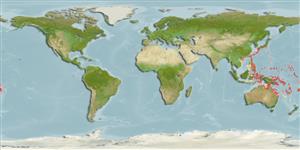Classification / Names
Common names from other countries
Main reference
Size / Weight / Age
Max length : 6.0 cm SL male/unsexed; (Ref. 48637)
Environment
Marine; reef-associated; depth range 3 - 45 m (Ref. 397), usually 20 - 45 m (Ref. 397)
Climate / Range
Tropical; 21°C - 27°C (Ref. 27115), preferred ?; 35°N - 30°S
Distribution
Western Pacific: Indonesia, New Guinea, the Solomon Islands, the northern Great Barrier Reef, and southern Japan. Replaced by Stonogobiops dracula in the Indian Ocean (Ref. 37816).
Countries | FAO areas | Ecosystems | Occurrences | Introductions
Short description
Dorsal
spines
(total): 7;
Dorsal
soft rays
(total): 11;
Anal
spines: 1;
Anal
soft rays: 10;
Vertebrae: 26. Eyes and mouth large. Angle of jaws 20-30 degrees. Heads pores absent. Scales on thorax and pectoral base absent to few small ones. Longitudinal scale series 75-92, transverse 19-23. Anterior part of head bright yellow; adults with dark head band ending on lower margin of preoperculum. 1st to 4th dorsal spines prolonged in adults; 2nd dorsal fin light blue with fine reticulum of yellow. Pectoral fins pointed. Palatine with tooth-like projections. Median predorsal region naked.
IUCN Red List Status (Ref. 115185)
Threat to humans
Harmless
Human uses
Aquarium: commercial
More information
Common namesSynonymsMetabolismPredatorsEcotoxicologyReproductionMaturitySpawningFecundityEggsEgg development
ReferencesAquacultureAquaculture profileStrainsGeneticsAllele frequenciesHeritabilityDiseasesProcessingMass conversion
Tools
Special reports
Download XML
Internet sources
Estimates of some properties based on models
Phylogenetic diversity index
PD50 = 0.5078 many relatives (e.g. carps) 0.5 - 2.0 few relatives (e.g. lungfishes)
Trophic Level
3.3 ±0.3 se; Based on size and trophs of closest relatives
Resilience
High, minimum population doubling time less than 15 months (Preliminary K or Fecundity.)
Vulnerability
Low vulnerability (16 of 100)
Price category
